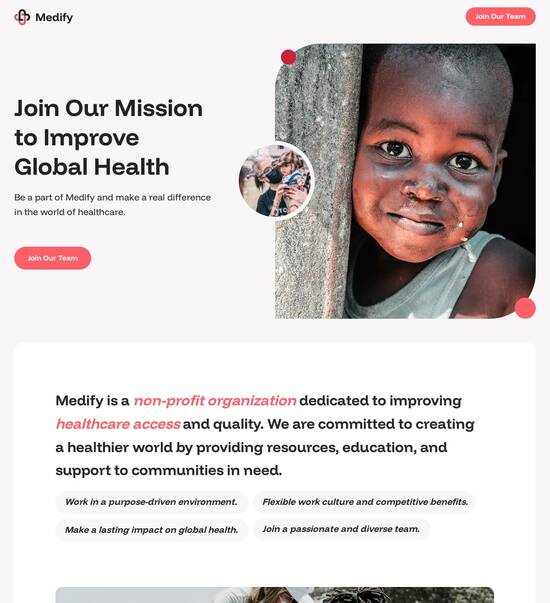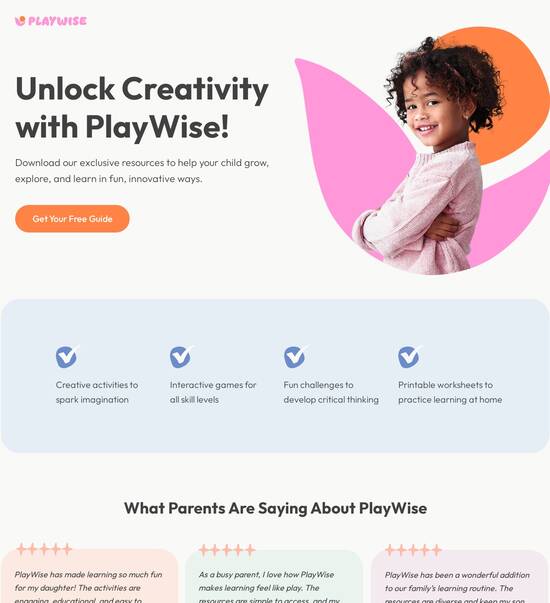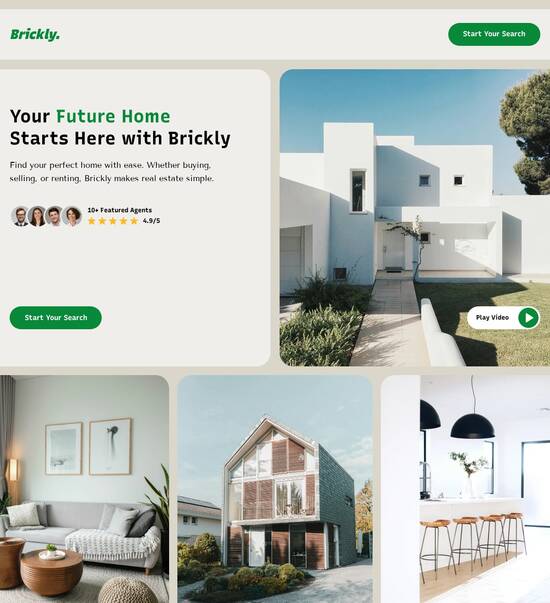
Web page template for Art directors
Use TemplateAbout template
Attract clients and showcase your skills with style using our landing page templates for Art directors. Let's convert those visitors into clients!
Recommended templates

Easy to build without coding
With the intuitive drag-and-drop builder, anyone on your team can create high-converting pages without any knowledge of code or design. Make enhancements to your landing page with custom widgets using Javascript, HTML/CSS, or third-party scripts.

Multiple layouts for any industry and goal
Select from 500+ landing page layouts built to boost conversions across industry-specific scenarios. Customize them by adjusting fonts, adding images, and generating on-brand content with the AI assistant. Quickly scale with Instablocks® and Global Blocks that you can save, reuse, and update globally.

Loads fast and looks polished on any device
Every template is responsive, which means they present professionally on any device and load blazingly fast with our Thor Render Engine. You can also power them up with Google AMP technology to deliver an unparalleled mobile experience and drive higher conversions.

Robust analytics & experimentation
Get real-time updates and reporting across all your devices, showing the number of visitors, conversions, cost-per-visitor, and cost-per-lead. Launch AI-powered experiments, run A/B tests, and use heatmaps to analyze user behavior, then optimize your landing page to maximize conversions.







Easy to build without coding
With the intuitive drag-and-drop builder, anyone on your team can create high-converting pages without any knowledge of code or design. Make enhancements to your landing page with custom widgets using Javascript, HTML/CSS, or third-party scripts.
Multiple layouts for any industry and goal
Select from 500+ landing page layouts built to boost conversions across industry-specific scenarios. Customize them by adjusting fonts, adding images, and generating on-brand content with the AI assistant. Quickly scale with Instablocks® and Global Blocks that you can save, reuse, and update globally.
Loads fast and looks polished on any device
Every template is responsive, which means they present professionally on any device and load blazingly fast with our Thor Render Engine.
Robust analytics & experimentation
Get real-time updates and reporting across all your devices, showing the number of visitors, conversions, cost-per-visitor, and cost-per-lead. Launch AI-powered experiments, run A/B tests, and use heatmaps to analyze user behavior, then optimize your landing page to maximize conversions.
All the features you need to build art web page template
Explore more featuresLearn how to build top-performing landing pages for any goal
FAQs
Leading the way in building high-performing landing pages





A comprehensive guide to optimizing landing pages on Instapage
Instapage provides marketers with an exceptional landing page and conversion rate optimization platform designed to maximize the ROI of digital marketing campaigns. With its user-friendly interface and powerful optimization tools, crafting effective landing pages is more straightforward than ever.
Understanding the importance of effective landing pages
Landing pages are critical elements in the digital marketing strategy as they effectively capture leads and encourage conversion. By focusing on key aspects such as design, content, and functionality, marketers can enhance the user experience and increase conversion rates significantly.
- High-converting templates
- Instapage offers over 100 ready-to-use templates that are proven to convert effectively, saving time and ensuring you don't start from ground zero.
- Optimized landing pages
- Create and customize landing pages using an intuitive platform that does not require any coding, allowing marketers of all skill levels to build effective pages quickly.
- Data-driven optimization
- Utilize built-in analytics and A/B testing features to optimize your pages based on user behavior, ensuring each iteration leads to better performance.
Step 1: Choose the right template
Selecting an appropriate template is foundational to your landing page's success.
Step 2: Customize your content
Personalization is key. Adjust the content to align with your audience's interests and needs.
- Dynamic text replacement
- Use dynamic text features to tailor messaging directly to user segments for better engagement.
- Stunning visuals
- Incorporate high-quality images and thoughtful layouts to draw attention and facilitate absorption of key messages.
- Strong calls to action
- Craft compelling CTAs that prompt users to take the desired action, significantly boosting conversion rates.
Step 3: Analyze and optimize
Once your page is live, continual optimization is essential to maximize conversions.
- Monitor performance with analytics
- Use Instapage’s analytics tools to track user interactions and identify bottlenecks in the conversion process.
- Conduct A/B testing
- Regularly test different elements of your landing page, including headlines, visuals, and CTAs, to discover what resonates best with your audience.
- Leverage heatmaps
- Heatmaps can provide insights into how users interact with your page, guiding adjustments to improve the user experience.
Incorporating these steps into your digital marketing strategy can immensely elevate your landing page performance and drive greater ROI.
Explore the full potential of Instapage today and transform your lead generation strategy. Get started with a free trial and see the difference!
People also ask about Web page template for Art directors
Web page template for art directors: A comprehensive guide
Understanding the unique needs of art directors
Art directors play a pivotal role in shaping creative projects, bringing a unique vision to visual storytelling. They are responsible for the overall aesthetic and conceptual direction of a project, whether it be in advertising, publishing, or digital media. This position requires not only an artistic flair but also the capability to oversee various components of a project. Art directors collaborate with different teams, including graphic designers, copywriters, and marketing professionals, to ensure that the visual narrative aligns with the brand's message and objectives.
However, this role is not without its challenges. Balancing creativity with functionality poses a significant hurdle for art directors. They must create visually appealing designs while ensuring that these designs communicate effectively and serve their intended purpose. This requires the use of efficient workflow tools that streamline the creative process and facilitate collaboration among team members. Additionally, maintaining brand consistency across various platforms and media types can be demanding, as art directors need to keep the brand's identity intact while adapting to different design requirements.
Key features of web page templates designed for art directors
Web page templates tailored for art directors must encompass functionalities that align with their creative demands. One top feature is a drag-and-drop interface, allowing art directors to edit and customize templates seamlessly without needing extensive technical skills. Pre-built design elements provide a powerful toolkit, offering art directors access to aesthetically refined components that can be easily integrated into their projects. These features not only save time but also empower artists to focus on creativity, rather than on cumbersome technical aspects.
Browser compatibility and mobile optimization are crucial components of modern templates. Art directors must ensure their designs deliver consistent viewing experiences across various devices, enhancing accessibility. Responsive design is fundamental; it allows templates to adapt to different screen sizes without compromising visual integrity. Additionally, the inclusion of video content has become increasingly important. Templates should allow easy integration of multimedia elements, providing tips for optimizing video sizes and loading times to ensure fast and engaging user experiences.
A palette of colors to reflect brand identity
Color plays a vital role in design, influencing viewer perception and emotional response. Art directors must integrate color theory into their projects to create visually harmonious layouts. Understanding how color combinations affect readability and the overall impact of a design is fundamental. Utilizing contrasting colors can draw attention to key elements, while complementary colors create a sense of balance. This knowledge allows directors to craft visual experiences that resonate with audiences on a deeper level.
Customization options should include a variety of shades, gradients, and palettes. Tools for color selection and scheme testing empower art directors to experiment and refine their work. Best practices involve not just color choice but also understanding how to apply these colors effectively throughout a design. Consistency in color application across various materials ensures brand recognition and establishes a solid visual identity.
Website template builder as a creative power tool
A powerful website template builder can significantly enhance an art director’s workflow. Features that improve user experience include intuitive navigation for quick access to various templates, enabling rapid project turnaround. Furthermore, the ability to store and organize favorite designs simplifies the search process, allowing directors to focus more on creative aspects rather than administrative tasks.
Finding and utilizing pre-designed templates can also streamline the creative process. Templates categorized for specific art projects provide art directors with a head start. They can be customized to suit individual project needs, which not only preserves the uniqueness of each project but also boosts efficiency. By leveraging these tools, art directors can significantly reduce production time while maximizing the quality of their work.
Typography that captivates and communicates
Typography is another critical element in web design that affects brand messaging. The right fonts can convey tone and align with the audience’s expectations. Art directors must consider factors such as hierarchy and readability when selecting typography for their projects. Effective headline placement and font style selection can grab attention and guide viewers through the content efficiently.
Accessing diverse font libraries through web page templates allows art directors to explore various typography options. Pairing fonts correctly contributes to a cohesive visual narrative. Tips for effective font pairing include contrasting styles for headlines and body text to enhance readability while maintaining aesthetic appeal. This strategic approach to typography helps ensure that the overall message is communicated clearly and engagingly.
Structuring content with effective layouts
The structure of content is vital in helping viewers navigate a webpage effortlessly. Header placement is crucial; crafting engaging headlines can draw attention and entice readers to explore further. Positioning headers for optimal visibility is a key strategy to make the most impact. Effective layouts provide clarity and flow, guiding the audience’s eye through the design.
Utilizing columns is another effective method to organize content. Column layouts can break up text-heavy sections, making information more digestible for readers. Tips for maintaining visual balance include adjusting column widths and ensuring adequate spacing between elements. By structuring layouts effectively, art directors can create user-friendly designs that enhance overall engagement.
Innovative design elements to enhance user engagement
Incorporating interactive features into web designs can substantially enhance user engagement. Elements that encourage user interaction, such as clickable call-to-action buttons or hover effects, can make the experience more dynamic. Additionally, using animations judiciously can further enrich the user experience, drawing attention to key messages while keeping the overall design cohesive.
Establishing a visual hierarchy is crucial for directing viewer focus. By strategically placing images and text, art directors can guide users through the content effectively. Balancing these elements ensures that users don't become overwhelmed by visual stimuli and can engage with the message being conveyed. Thoughtful design leads to an interactive experience that holds the audience's attention.
The role of images in conveying aesthetic value
Curating high-quality image content is essential for maximizing impact in web design. Sourcing visually appealing and relevant images enhances storytelling and supports the overall aesthetic of a webpage. Furthermore, art directors need to be vigilant about image licensing and copyright to avoid legal complications. Understanding these factors means that every image selected contributes positively to the project's integrity.
Integrating images seamlessly into templates requires best practices in image sizing and positioning. Images should be optimized for the web, ensuring fast load times without sacrificing quality. Creating cohesive visual narratives involves thoughtful placement of images alongside text, fostering a harmonious design that keeps viewers engaged. The use of images effectively helps to reinforce the brand’s message and values.
Addressing common problems in web page design
Web page design can sometimes present challenges, particularly with layout issues. Troubleshooting responsive design challenges often requires a thorough understanding of breakpoints and alignment settings. Common strategies include using CSS media queries and flexible grid layouts to ensure that designs function flawlessly across various devices and screen sizes.
Additionally, optimizing for load speed and performance is essential for user retention. A slow-loading page can drive users away; thus, minimizing resource-heavy elements is important. Implementing strategies such as image compression and script optimization can significantly enhance load times, ensuring that users have positive experiences without unnecessary delays.
Leveraging the download panel for efficient workflow
A download panel can streamline the design process by facilitating quick access to downloadable assets. This feature ensures that art directors can find necessary components quickly and efficiently, reducing time spent searching for files. Additionally, integration with other design tools promotes collaboration, allowing teams to share resources effortlessly and maintain project momentum.
Customization and version control are crucial aspects of managing design iterations. Keeping track of changes made throughout the project aids in maintaining clarity amongst team members, ensuring that everyone has access to the most current versions. This organized approach fosters smoother workflow practices and enhances team collaboration.
Conclusion: Transforming the art direction landscape with web templates
Web page templates offer a robust solution for art directors, empowering them with the tools needed to streamline their creative processes. These templates encourage creative expression within a digital space, allowing for imaginative designs that maintain productivity and efficiency. As the demands of web design evolve, templates will continue to play a pivotal role in helping art directors achieve their vision.
Looking ahead, several trends are shaping how designers create and collaborate. Innovations in technology are fostering new ways for creative professionals to engage with one another and push boundaries in their work. By leveraging these advancements, art directors can shape the future of design and deliver impactful visual experiences that resonate with diverse audiences.
Ready to skyrocket conversions?
Supercharge your ad campaigns with high-performing landing pages
Get started














